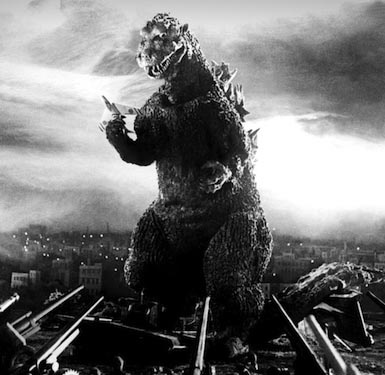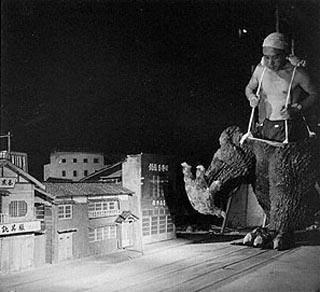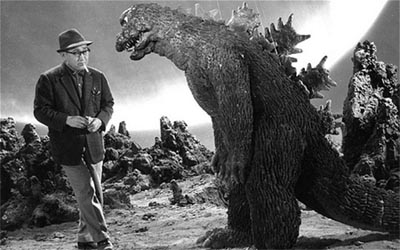Monster
of Monsters: Godzilla
|

Godzilla
stares down the army in a publicity still from his first
film in 1954.
|
In 1954, Japanese film producer Tomoyuki Tanaka
was pondering the recent, accidental exposure of some fishermen
to radiation from an American H-bomb test when suddenly he had
an idea for a film. It would feature an aquatic, lizard-like
creature grown to gigantic proportions by atomic radiation.
His beloved skyscraper-high creation would eventually be featured
in over 30 films and be adored by monster movie fans around
the world.
On March 1, 1954, the United States tested the
first hydrogen bomb that was small enough to fit into an aircraft.
The experiment, code named Castle Bravo, took place at Bikini
Atoll part of the Marshall Islands in the Pacific. Scientists
miscalculated how large the blast would be, however, getting
a 15-megaton explosion instead of the 6-megaton one they expected.
Because of this, the resulting fallout area was enormous and
a small Japanese fishing trawler, Lucky Dragon 5, its crew and
cargo got irradiated. The event caused an international incident.
Concerns were particularly high in Japan that such tests might
contaminate the country's food supply, much of which came from
the sea.
It was during this period that Tomoyuki Tanaka,
a producer for the Toho Motion Picture company, found himself
flying back from an unsuccessful attempt to negotiate the filming
of a movie in Indonesia. The cancellation of the film left a
hole in Toho's production schedule that Tanaka needed to fill
as quickly as possible. Tanaka had an interest in monster films
and had been reading in a trade magazine about the production
of an American movie called The Beast from 20,000 Fathoms.
The film told the tale of a dinosaur frozen in the Arctic which
was resurrected by an atomic blast. The creature then swam south
and laid waste to New York City.
Tanaka realized that he could use the H-bomb tests
in the Pacific as the backdrop for his own monster story. He
quickly wrote an outline about a prehistoric creature that emerges
out of the sea to assault Tokyo. He gave it the working title
of The Giant Monster from 20,000 Leagues Under the Sea.
The studio decided to approve the movie's production
with Eiji Tsuburaya as the visual effects expert and Ishiro
Honda as the director. A name was needed for the creature and
legend has it that an especially strong employee of the company
sported the nickname Gojira, which was a combination
of the words for gorilla and whale. The film crew soon started
calling the creature in the film this name, which in English
is Godzilla, and it stuck.
Suitmation
|

Ray
Harryhausen's Beast from 20,000 Fathoms inspired
producer Tanaka to create Godzilla.
|
One of the first questions the production crew
had to tackle was how to bring the monster to life. The Beast
from 20,000 Fathoms had Ray
Harryhausen as its visual effects expert. Harryhausen was
an expert at a technique called stop motion
animation. This method had been used before (notably in
the film King Kong) and it involved creating a miniature set
with a poseable puppet of the monster. The action was then filmed
one frame at a time with the puppet being manipulated between
each shot. When the film was developed and played back at full
speed, it would appear as if the puppet was moving by itself.
Doing good stop motion animation, however, was
a time-consuming and exacting process. Tsuburaya estimated that
with his current resources and expertise, filming Godzilla via
stop motion would take around 7 years. This was far too long
as Toho's management wanted the picture in the theaters by the
end of the year.
While Toho Studios had little familiarity with
stop motion, it did have many artisans with extensive experience
in building scale models. During World War II the studio had
made a number of propaganda films sponsored by the government.
These included complex battles scenes (such as the attack on
Pearl Harbor) reproduced in miniature. Some of the battle scenes
were so convincingly real that they wound up in documentaries
after the war.
Though it had never been done before, Tusburaya
decided he could build miniature sets scaled to a human-sized
monster that was actually an actor in a rubber suit. If the
man in the monster suit was filmed with the camera running at
several times normal speed (240 frames a second), he would move
in slow motion, helping with the illusion that he was many hundreds
of feet tall. Eventually this technique, pioneered by Tusburaya,
would get the name Suitmation.
Making
the Monster
One of the first concerns was to come up with
a design for the monster and actually build the suit. A popular
comic book illustrator, Wasuke Abe, was hired for the job, but
his creation turned out to be very abstract (the creature sported
a head the shape of a mushroom cloud) and not what Tusburaya
wanted. During an interview with the artist, however, they looked
at illustrations that featured a Tyrannosaurus Rex. As it turned
out this was to have a major influence on their final vision.
|

The
half suit in operation.
|
A sculptor was commissioned to make several models
of the monster in clay with different characteristics. In the
end, the filmmakers decided on a version of the creature that
was a cross between a T-Rex and an iguanodon with plates down
its back like a stegosaurus The monster also was given alligator-like
skin.
Nobody had ever built a monster suit like this
so the Toho crew was on their own to figure it out via trial
and error. They started with a chicken-wire frame which was
coated with layers of hot latex rubber. The details of the creature's
skin and features were created separately and glued onto the
top layer by the studio's artists. When it was time to test
the suit with an actor, the final product looked wonderful,
but was so inflexible and heavy that the actor collapsed after
only taking a few steps.
It became clear that the suit was too heavy and
stiff. It would have to be built over again. This time the crew
chose a more flexible form of rubber and tried to minimize the
weight. Even so, the creation weighed in at 220 pounds and with
little ventilation was suffocatingly hot. One of the two actors
who shared the role, Haruo Nakajima, claimed he had to drain
a cup of sweat out of the suit after filming each scene.
The original latex suit, however, was not wasted,
but with the top cut off and suspenders added, was used in close
up shots of Godzilla's feet as he rampaged through the city.
The filmmakers not only wanted to get the Godzilla
suit itself correct, they also wanted accuracy in the locations
the creature would ravage. They spent an enormous amount of
time looking at and taking pictures of real locations they wanted
to reproduce in miniature for certain scenes. Once, while standing
atop the Matzuzakaya Department store, they discussed which
of the buildings in the surrounding area would be set on fire
or destroyed in the film. Someone overheard their conversation
and by the time they reached the building exit, they were stopped
by the authorities and had to answer some questions about their
conversation. Fortunately, after identifying themselves as filmmakers,
they were allowed to go on their way.
Filming
the Creature
Shooting started in August of 1954 and it was
not without its difficulties. The actors inside Godzilla, Haruo
Nakajima and Katsumi Tezuka, found working conditions to be
grueling. The suit itself was hot and when put under the brilliant
studio lights, it became almost unbearable. The actors also
had to contend with the smell of burning kerosene used to light
the miniature sets of Tokyo ablaze. On one occasion Tezuka and
several of the crew were almost electrocuted when a live cable
fell into the pool set in which they were shooting a water scene.
There were cases when actors inside Godzilla fainted in the
middle of a scene as they were overcome by the heat and lack
of ventilation.
|

The
director with his star on the set.
|
The actors entered the suit through an opening
that ran in between the dorsal fins which was then zippered
closed. Because the costume was taller than the actors, their
heads were actually located in the creature's neck area. Tiny
holes had been put in the suit here to allow the actors to see
out and get air. Unfortunately, during filming the holes clogged
up with sweat and often the actors found themselves operating
with nearly no vision at all.
Though Haruo Nakajima and Katsumi Tezuka did the
work inside the suit, they were not the only people responsible
for Godzilla's performance. Cables were used to control the
motions of his eyes, and another cable was connected to his
tail to control which way it would swing.
The production finished on time, but because of
all the special effects and miniature work Godzilla turned out
to be the most expensive motion picture made in Japan up to
that time. With a price tag of over one hundred million yen
($1.5 million in 1954 dollars), it was an enormous financial
gamble for the studio.
Fortunately, Godzilla was a huge success and a
sequel was soon in the works. Godzilla Raids Again was
the first of many encores for the giant lizard.
Godzilla
Comes to America
The next year a group of American investors purchased
the international rights to Godzilla. They believed the
film would be more successful if it included an American actor,
so they hired Raymond Burr (who would later become well-known
for his portrayal of the TV lawyer, Perry Mason) to play
the part of a U.S. reporter covering the attack of Godzilla
in Japan.
A number of new scenes were shot over the course
of five days. These were then inserted into the original film
and it was released to U.S. audiences in 1956 as Godzilla,
King of the Monsters. It was a box office hit.
To date, Godzilla has appeared in 30 films. Some
of these include King Kong vs. Godzilla, Ghidorah,
the Three-Headed Monster, Son of Godzilla, The
Return of Godzilla and Godzilla Against Mechagodzilla.
As the Tokyo skyline has gotten taller, so has Godzilla so that
he continues to dominate the landscape. In the original 1954
film he stood about 160 feet (50m) high. By 2014, in the U.S.
movie of that year, he had grown to 350 feet tall (106 meters).
His recognition is worldwide, but he is particularly
popular in Japan where he has become a national icon. Over the
course of the movies Godzilla has become a sympathetic figure,
occasionally battling other monsters to save his adopted home.
He doesn't like humans, but will team up with them against common
threats.
He has also spawned a number of spin-offs and
competitors. The term Kaiju (which translates to "strange
creatures") is the name of this genre. It includes Toho's giant
sized hero Ultraman, as well as Daiei Motion Picture
Company's rival monster Gamera.
How long will Japan's most admired monster continue
to make films? Given his popularity in his homeland, as well
as around the world, it looks like we will be seeing the giant
lizard for many, many more years.

Copyright Lee Krystek 2014.
All Rights Reserved.